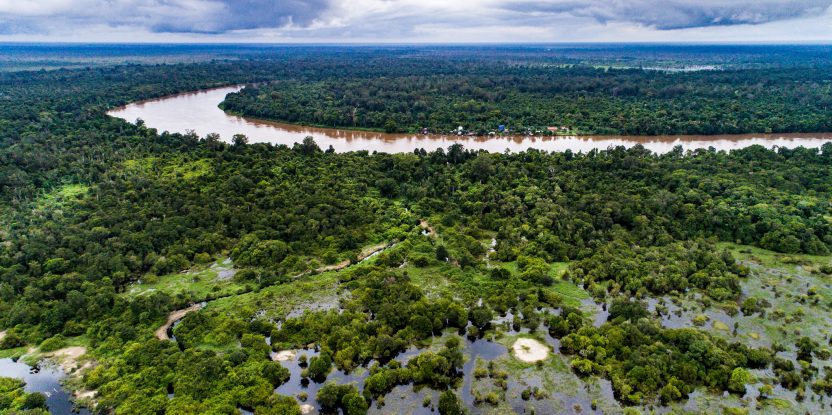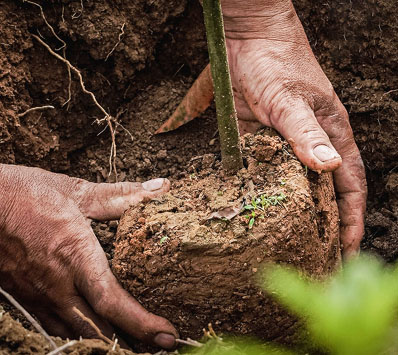
A foundational challenge of environmental governance is that of transboundary issues. By their very nature, environmental phenomena don’t obey regional, national, or continental boundaries – so their management necessitates special kinds of collaboration, often between large numbers of leaders and institutions.
Haze pollution is perhaps the archetypal transboundary issue. Every year, haze from dry-season forest fires drifts across much of Southeast Asia – particularly its southernmost countries of Malaysia, Singapore, and Indonesia, but also in the northern areas of Thailand, Myanmar, Lao DPR, and Cambodia. The phenomenon has major environmental, economic, and health impacts, such as causing further fires, degrading forest ecosystem services, exacerbating climate change, damaging agricultural and fisheries, halting air travel, causing respiratory diseases and eye and throat infections, and impacting the health of endemic and threatened species like orangutans – among myriad other effects. The World Bank estimated Indonesia’s economic losses from the 2019 fires at about USD 5.2 billion, and one estimate put total economic losses from the six largest fire events between 2004 and 2015 at USD 93.9 billion.
Now, as the swing to the El Niño weather pattern ushers in a longer, hotter dry season for the region, attention is firmly fixed on Southeast Asia’s response. Fortunately, the region’s nations have collaborated for decades to mitigate the incidence and implications of haze pollution.
The ASEAN Summits held in September 2023 and October 2024, respectively, showcased notable progress through several key developments. These include the inauguration of the ASEAN Coordinating Centre for Transboundary Haze Pollution Control (ACC THPC), the signing of the Establishment Agreement for the ACC THPC by seven ASEAN Member States and the adoption and implementation of the Second Haze Free Roadmap and Second ASEAN Peatland Management Strategy. As we mark these milestones – twenty years after the inception of the Association of Southeast Asian Nations (ASEAN) Agreement on Transboundary Haze Pollution (AATHP) – it’s crucial to reflect and consider what’s been learned and identify the steps needed moving forward, as climate change and seasonal fluctuations pose the risk of increasingly severe weather events in the future.
Why does the AATHP matter?
The signing of the AATHP in 2002 marked a pivotal step in Southeast Asia’s collective response to the persistent environmental and health challenge posed by transboundary haze. The agreement’s implementation is overseen by the Conference of the Parties (COP), supported by a Committee (COM), while various Technical Working Groups (TWGs) and Sub-regional Ministerial Steering Committees (MSCs) offer targeted expertise and foster regional collaboration to combat haze pollution.
The AATHP was initiated following several key developments in organisational development towards improved monitoring and collective responsibility for environmental challenges. These included the 1990 Kuala Lumpur Accord on Environment and Development, the establishment of the ASEAN Specialised Meteorological Centre (ASMC) in Singapore in 1993 to provide critical weather and climate services, and the 1995 ASEAN Cooperation Plan on Transboundary Pollution, which launched the Haze Technical Task Force (HTTF). This task force produced a manual on implementing measures to mitigate and control haze-causing land and forest fires and formulated the Regional Haze Action Plan (RHAP), endorsed by the ASEAN Ministerial Meeting on Haze (AMMH) in 1997. Under the RHAP, ASMC was designated as the regional hub for monitoring and assessing land and forest fires, as well as issuing early warnings on transboundary haze, initially on southern ASEAN and then extended to the entire region by 2002.
The AATHP underscores the importance of coordinated national initiatives, along with strengthened regional and international cooperation to tackle transboundary haze, fires and their underlying drivers. In 2003, six ASEAN member states ratified the AATHP and by 2015, all member states had integrated it into their national legal frameworks.
Then, to further operationalize the implementation of the AATHP, in 2016, ASEAN member states developed the Roadmap on ASEAN Cooperation towards Transboundary Haze Pollution Control with Means of Implementation (referred to as the ASEAN Haze-free Roadmap). This document sets out several strategic components for translating the principles of the AATHP into concrete and collective action, such as sustainably managing agricultural, peatland, and forest landscapes; enhancing institutional cooperation and capacity; building public awareness and stakeholder participation; and securing adequate resources to prevent transboundary haze, among others.
In August of 2023, ASEAN adopted the Second ASEAN Haze-Free Roadmap (2023-2030), which was officially launched in February 2024, building on the first Roadmap and its review. This new Roadmap aims to eliminate regional transboundary haze pollution by 2030 through the effective implementation of collective actions to prevent and control land and forest fire by improving regional capacity, implementing tailored subregional strategies, promoting sustainable land use practices, implementing best peatland management practices, securing resources, strengthening national policies, enhancing cooperation, raising public awareness, and mitigating the impacts of haze on various sectors. It also includes actions, responsible parties, target areas, resources, and progress measures for each strategy and provides guidance on constructing a monitoring and evaluation framework with regional and national level indicators/targets for reporting and data sharing.
The AATHP laid the groundwork for establishing the ASEAN Task Force on Peatlands. This task force assisted member states in monitoring and supporting the implementation of the ASEAN Peatland Management Strategy (APMS) from 2016 to 2020 and now backs the new APMS (2023-2030), which was adopted alongside the Second Haze-Free Roadmap. The task force also oversees the implementation of peatland initiatives, such as the ASEAN Peatland Forests Project (APFP), the Sustainable Management of Peatland Forests in Southeast Asia (SEApeat) project, the Sustainable Use of Peatland and Haze Mitigation in ASEAN (SUPA) programme, and the Measurable Action for Haze-Free Sustainable Land Management in Southeast Asia (MAHFSA) programme.
Further, the Agreement mandated the establishment of the ASEAN Coordinating Centre for Transboundary Haze Pollution Control (ACC THPC) to facilitate cooperation and coordination in managing the impacts of land or forest fires and their associated transboundary haze pollution. The Centre was formally introduced at the opening of the 43rd ASEAN Summit in Jakarta.
Complementing these efforts, ASEAN has developed and endorsed the Investment Framework for Haze-Free Sustainable Land Management (AIF-HFSLM) for 2023-2020, aiming to help build multi-stakeholder partnerships and secure resources to stop large-scale burning of forests, peatlands, and agricultural residue by establishing socially and economically viable alternatives.
Progress, challenges, and prospects
In a policy dialogue titled ‘Moving toward the implementation of the ASEAN Haze-Free Roadmap’ held in July 2023 in Putra Jaya, Malaysia, attendees reviewed the Agreement’s progress and need for future implementation.
Speakers praised progress on the development of an investment framework as a means of implementation of the Second Haze-Free Roadmap and APMS and the development of a broad vision that emphasizes prevention, science-based targets, smart economic and social instruments, integrated development that incorporates climate change and development goals, involving and empowering local communities, alternatives to zero-burning policies, and acknowledgement of the unique sub-regional contexts whilst enhancing connectivity across and beyond the region.
They noted challenges such as the institutionalization of early haze assistance systems and the establishment and full operation of national monitoring and warning systems that keep track of indicators such as air quality, hotspots and burned areas – and hold member states to high standards in this regard. These challenges and the commitment to move forward are captured in the words of Dr. Kao Kim Hourn, Secretary-General of ASEAN,
“As we embark on the journey as outlined in this Second Roadmap, let us remain resolute in our commitment to mobilize resources, strengthen legal and policy frameworks at all levels, enhance cross-sectoral cooperation and coordination, and increase public awareness and engagement. Together, we will overcome the challenges posed by transboundary haze and forge a future where clean air and sustainable development prevail for the well-being of the people of ASEAN. We must work together to restore and heal nature so as to heal ourselves.”
As climate change exacerbates extreme weather conditions and global concerns about carbon emissions continue to rise, the lessons learned from the ATTHP over its twenty-year journey are more crucial than ever. The agreement has spurred significant changes and new guidance documents such as the Second Roadmap, APMS and the ASEAN Investment Framework while fostering regional cooperation to address the persistent issue of haze pollution. However, the commitments and actions taken moving forward will be critical in meeting climate change’s challenges, particularly in preventing the worsening of haze pollution and its impacts across Southeast Asia.
Acknowledgements
This article is a part of the Measurable Action for Haze-Free Southeast Asia (MAHFSA) programme, a joint initiative between ASEAN and the International Fund for Agricultural Development (IFAD) that supports efforts to reduce transboundary haze pollution and its impact in Southeast Asia. This article was developed with the assistance of ASEAN Secretariat members Mardiah Hayati, Wiraditma Prananta, Etwin Kuslati Sabarini and Dyah Ayu Ritma Ratri.
We want you to share Forests News content, which is licensed under Creative Commons Attribution-NonCommercial-ShareAlike 4.0 International (CC BY-NC-SA 4.0). This means you are free to redistribute our material for non-commercial purposes. All we ask is that you give Forests News appropriate credit and link to the original Forests News content, indicate if changes were made, and distribute your contributions under the same Creative Commons license. You must notify Forests News if you repost, reprint or reuse our materials by contacting forestsnews@cifor-icraf.org.
